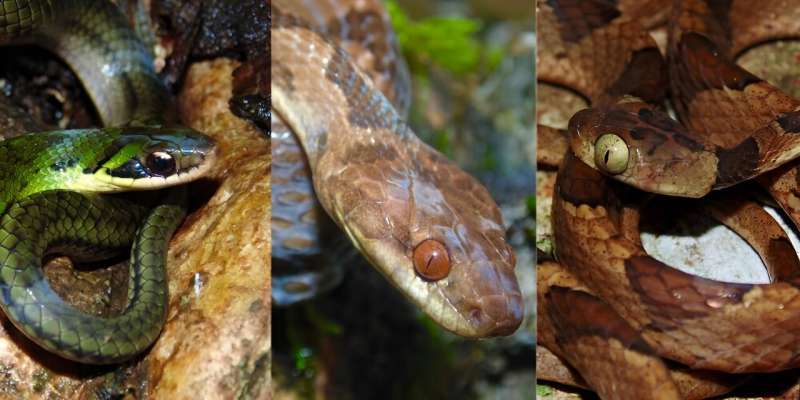This article has been reviewed according to Science X's editorial process and policies. Editors have highlighted the following attributes while ensuring the content's credibility:
fact-checked
peer-reviewed publication
trusted source
proofread
Snake skulls show how species adapt to prey

By studying the skull shapes of dipsadine snakes, researchers at The University of Texas at Arlington have found how these species of snakes in Central and South America have evolved and adapted to meet the demands of their habitats and food sources.
The research, conducted in collaboration with colleagues at the University of Michigan, was published in BMC Ecology and Evolution.
"We now have evidence that this group of snakes is one of the most spectacular and largest vertebrate adaptive radiations currently known to science," said Gregory Pandelis, collections manager at UTA's Amphibian and Reptile Diversity Research Center. "We found that both habitat use and diet preferences are strongly correlated to skull shape in this group of snakes, indicating these are likely factors driving cranial evolution for these species."
There are more than 800 species of dipsadine snakes, ranging from less than 12 inches to more than 9 feet in length. This subfamily of snakes is usually harmless to humans and survives on a wide range of foods—from larger creatures like birds, lizards, and frogs to smaller, slimier prey like frog eggs, worms, and slugs. Some species specialize in consuming specific prey—like snails—while others are generalists.
Researchers focused on skull evolution because skull shape has important functional consequences for snakes, including prey acquisition and ingestion, habitat use, mate choice, and defense against predators. Snakes, of course, don't have limbs, so their skulls play a critical role in moving through their habitat and catching and eating prey much larger than their body size would suggest is possible.
To examine the evolution of skull shape, researchers created 3D digital reconstructions for the skulls of 160 species of dipsadine snakes using X-ray microcomputed tomography-scanning technology (CT scanning) of preserved museum specimens. They then quantified their shape using geometric morphometrics and paired this with data they collected in the field on how these snakes lived and what they ate to explore the relationship between skull shape and ecology.
"Our research shows that snakes that are aquatic (water) or fossorial (underground dwellers) seem to have the strongest selective pressure on their skulls, and evolutionary convergence is rampant among these groups," Pandelis said.
"There are only a few good evolutionary solutions to the difficult problems of trying to move through dirt and water efficiently. This study provides important insights into how snakes adapt to their highly unique ways of eating and inhabiting their environments, although there is much that we still don't know about these enigmatic and fascinating animals."
More information: Gregory G. Pandelis et al, Ecological correlates of cranial evolution in the megaradiation of dipsadine snakes, BMC Ecology and Evolution (2023). DOI: 10.1186/s12862-023-02157-3
Journal information: BMC Ecology and Evolution
Provided by University of Texas at Arlington




















